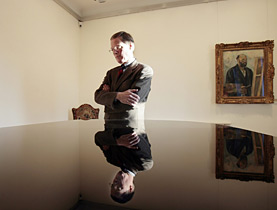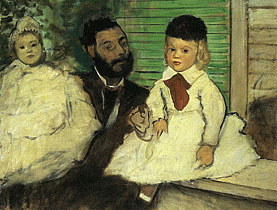Zurich museum counts cost of art theft

As Zurich police investigate the "art theft of the century", museum staff are left to contemplate the bare walls where works by Cézanne and van Gogh used to hang.
The private Bührle collection opened its doors to the media on Tuesday – two days after the audacious armed robbery. A white wall with scratch marks was all that was to be seen of the four missing pictures.
In all, art worth SFr180 million ($165 million) was stolen at gunpoint from the Zurich museum on Sunday.
“We have some information. We will now look how good this information is and the investigation will continue with high pressure,” Zurich police spokesman Marco Cortesi told swissinfo.
The heist was the largest of its kind in Switzerland, and one of the biggest worldwide. Newspapers have already dubbed it the art theft of the century.
There was no mistaking which building was the Bührle villa. The large house, in a normally quiet residential street in the upmarket Seefeld area of Zurich, was marked with a heavy police presence, both inside and out.
Inside journalists went up the very staircase used by the three masked suspects as they dashed up to the first floor landing, where they forced employees and some of the museum’s 15 visitors to the ground.
Cortesi said the men went straight into a large exhibition room on the left, where they took the four pictures – Cézanne’s The Boy in the Red Vest – worth SFr100m on its own – van Gogh’s Blossoming Chestnut Branches, Monet’s Poppies near Vétheuil and Degas’ Count Lepic and His Daughters – hanging in a row next to the door.
Scratches
The bare white wall, where the paintings once hung, stood out in the elegantly furnished room, which is set around a large piano. Other pictures still hang in the room.
Police believe the thieves were surprised by the weight of the works – on average 15kg each – and did not take due care. Dark scratches were visible on the wall. It cannot be ruled out that the pictures were damaged in some way.
“We think they took about three minutes and if you look at the marks here on the walls, you can see that it was very quick,” said Cortesi.
Employees observed a white vehicle leaving the scene shortly afterwards, although police believe that another vehicle could have been involved.
Movement sensors on the pictures alerted the authorities, which were on the scene shortly afterwards.
For Lukas Gloor, the museum’s director, it seems the men took the first four pictures they found rather than picking them according to value.
The room holds fine examples of Impressionist and post-Impressionist art, some of which – such as Cézanne’s self-portrait, which Gloor values at SFr90 million – are more valuable than some of the works stolen.
Gloor said that the museum’s policy of showing Emil Georg Bürhle’s collection as the industrialist, who died in 1956, might have lived with them was one of the reasons why the paintings seemed so vulnerable
Security
He said that the Bührle collection – whose security measures were aimed against theft and not armed robbery – and Swiss museums in general would now have to rethink security procedures.
“This is the first time that an armed robbery was carried out against a museum in Switzerland,” he told swissinfo.
“I’m afraid this means that we have reached a new level of protection which we have to face in the future, particularly as a small museum.”
Gloor mentioned glass walls and screening of visitors as possible measures. However, this would threaten the “intimate appeal” of such collections as the Bührle, he warned.
Experts say the well-known works are unlikely to be sold on the open market. A ransom demand has not been ruled out.
Cortesi said that the authorities were aware that stolen art might take time to find, or might never appear. Police are hoping for a good response from the public and remain positive, he said.
swissinfo, Isobel Leybold-Johnson at the Bührle villa
The art collection of Emil Georg Bührle (1890-1956), a Zurich industrialist, is among the most important private collections amassed in the 20th century of European art.
He acquired the lion’s share in the 1950s, but a few of the works he collected during the Second World War were discovered later to have been stolen by the Nazis.
In 1960 Bührle’s family placed 200 pieces in a foundation and opened it to the public. French Impressionism and Post-Impressionism constitute the core of the collection.
The Bührle collection’s security included burglar alarms to protect against break-ins during the night and an alarm system that sounded at the police station if a picture was moved. It has not been made clear whether there were guards or cameras operating during the day.
The collection is no longer open apart from for specially arranged group tours. Other Swiss museums have also been considering access and security measures.
The head of the Swiss Museums Association told the Swiss news agency on Tuesday that museums should not become fortresses, but that security would be a topic for members.
Other museums are said to be analyzing whether to increase measures, focusing on security checks on visitors with metal detectors, video surveillance or private security firms. Cost factors also have to be taken into account, said museums.

In compliance with the JTI standards
More: SWI swissinfo.ch certified by the Journalism Trust Initiative


You can find an overview of ongoing debates with our journalists here. Please join us!
If you want to start a conversation about a topic raised in this article or want to report factual errors, email us at english@swissinfo.ch.